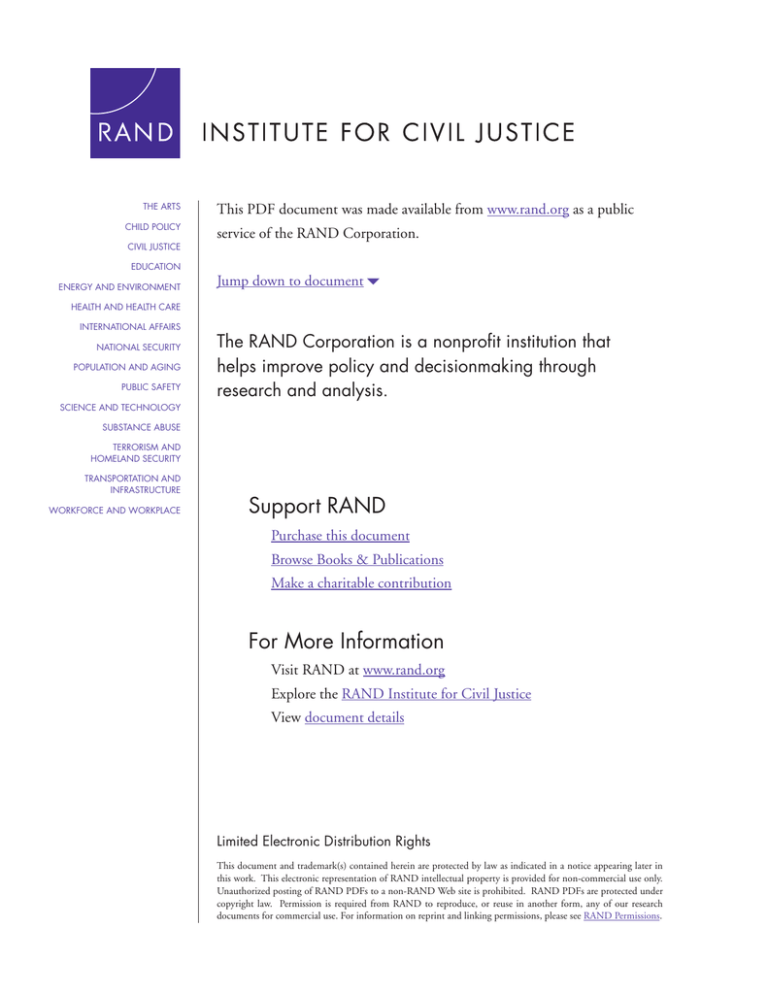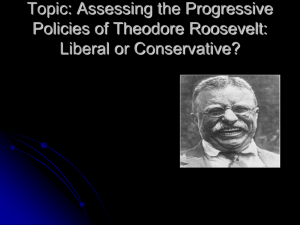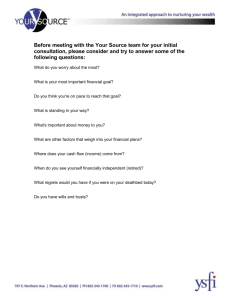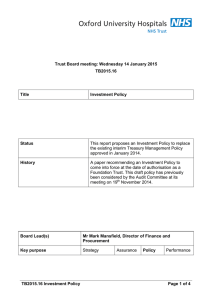6 om as a public service of the RAND Corporation.
advertisement

THE ARTS CHILD POLICY CIVIL JUSTICE EDUCATION ENERGY AND ENVIRONMENT This PDF document was made available from www.rand.org as a public service of the RAND Corporation. Jump down to document6 HEALTH AND HEALTH CARE INTERNATIONAL AFFAIRS NATIONAL SECURITY POPULATION AND AGING PUBLIC SAFETY The RAND Corporation is a nonprofit institution that helps improve policy and decisionmaking through research and analysis. SCIENCE AND TECHNOLOGY SUBSTANCE ABUSE TERRORISM AND HOMELAND SECURITY TRANSPORTATION AND INFRASTRUCTURE WORKFORCE AND WORKPLACE Support RAND Purchase this document Browse Books & Publications Make a charitable contribution For More Information Visit RAND at www.rand.org Explore the RAND Institute for Civil Justice View document details Limited Electronic Distribution Rights This document and trademark(s) contained herein are protected by law as indicated in a notice appearing later in this work. This electronic representation of RAND intellectual property is provided for non-commercial use only. Unauthorized posting of RAND PDFs to a non-RAND Web site is prohibited. RAND PDFs are protected under copyright law. Permission is required from RAND to reproduce, or reuse in another form, any of our research documents for commercial use. For information on reprint and linking permissions, please see RAND Permissions. This product is part of the RAND Corporation technical report series. Reports may include research findings on a specific topic that is limited in scope; present discussions of the methodology employed in research; provide literature reviews, survey instruments, modeling exercises, guidelines for practitioners and research professionals, and supporting documentation; or deliver preliminary findings. All RAND reports undergo rigorous peer review to ensure that they meet high standards for research quality and objectivity. REP O RT Asbestos Bankruptcy Trusts An Overview of Trust Structure and Activity with Detailed Reports on the Largest Trusts Lloyd Dixon • Geoffrey McGovern • Amy Coombe INSTITUTE FOR CIVIL JUSTICE The research described in this report was conducted by the RAND Institute for Civil Justice, a unit of the RAND Corporation. This research was supported by a coalition of asbestos defendants and insurers and by the RAND Institute for Civil Justice. Library of Congress Cataloging-in-Publication Data Dixon, Lloyd S. Asbestos bankruptcy trusts : an overview of trust structure and activity with detailed reports on the largest trusts / Lloyd Dixon, Geoffrey McGovern, Amy Coombe. p. cm. Includes bibliographical references. ISBN 978-0-8330-5037-3 (pbk. : alk. paper) 1. Bankruptcy trustees—United States. 2. Compensation (Law)—United States. 3. Personal injuries—United States. 4. Trusts and trustees—United States. 5. Asbestos—Law and legislation—United States. I. McGovern, Geoffrey. II. Coombe, Amy. III. Title. KF1530.R3D59 2010 346.7307'8—dc22 2010029003 The RAND Corporation is a nonprofit research organization providing objective analysis and effective solutions that address the challenges facing the public and private sectors around the world. RAND’s publications do not necessarily reflect the opinions of its research clients and sponsors. R® is a registered trademark. © Copyright 2010 RAND Corporation Permission is given to duplicate this document for personal use only, as long as it is unaltered and complete. Copies may not be duplicated for commercial purposes. Unauthorized posting of RAND documents to a non-RAND website is prohibited. RAND documents are protected under copyright law. For information on reprint and linking permissions, please visit the RAND permissions page (http://www.rand.org/publications/ permissions.html). Published 2010 by the RAND Corporation 1776 Main Street, P.O. Box 2138, Santa Monica, CA 90407-2138 1200 South Hayes Street, Arlington, VA 22202-5050 4570 Fifth Avenue, Suite 600, Pittsburgh, PA 15213-2665 RAND URL: http://www.rand.org To order RAND documents or to obtain additional information, contact Distribution Services: Telephone: (310) 451-7002; Fax: (310) 451-6915; Email: order@rand.org Summary Litigation over personal injuries due to asbestos exposure has continued for more than 40 years in the United States with hundreds of thousands of claims filed and billions of dollars in compensation paid. Many companies with significant liability for asbestos-related injuries have filed for bankruptcy, resulting in the creation of asbestos bankruptcy trusts, which pay claims on behalf of bankrupt defendants. These trusts are playing an increasingly important role in the compensation of asbestos-related injuries. While the role of trusts in providing compensation to asbestos claimants has grown, information about the operating procedures and activities of these trusts is not readily available in a convenient form. Little research has been done on transaction costs, time to claim disposition, claimant satisfaction, and other metrics of trust performance. In addition, there is little analysis of how the trusts have affected the overall compensation that asbestos claimants receive and the asbestos liabilities of solvent defendants and their insurers. This report provides an overview of asbestos PI trusts. It describes how they are created, how they are organized and governed, and how they operate. It also compiles publicly available information on the assets, outlays, claim-approval criteria, and governing boards of the leading trusts. This report does not attempt to evaluate trusts’ performance or assess how they have affected the overall compensation of asbestos claimants. Rather, it is meant to provide a readily accessible source of information on asbestos trusts that will help interested parties better understand how trusts operate and their activities to date. This report is part of a larger research project on asbestos bankruptcy trusts. A second report will examine how trust compensation or the potential for such compensation is taken into consideration in court proceedings and settlement negotiations. Data and Methods Data on the trusts were abstracted from publicly available sources including bankruptcy documents, trust websites, trust annual reports, and U.S. Securities and Exchange Commission (SEC) filings. To concentrate our efforts on the largest trusts, we selected a subset of the 54 trusts that had been set up through 2009. Twenty-six active trusts were chosen that met specified cutoffs based on the magnitude of assets available to the trust when it was established and the amount of claim payments through 2008. The 26 active trusts that met the criteria accounted for more than 99 percent of the claim payments that we could identify for all trusts through 2008. xi xii Asbestos Bankruptcy Trusts Detailed reports on the 26 selected trusts were prepared and then submitted to the relevant trusts for review. Twenty-three of the trusts were able to review the data, and the data were revised accordingly. The reports for the 26 active trusts, as well as for the three largest proposed trusts, are provided in Appendix B to this report. The overview of trust activity that follows is based on the 26 selected active trusts. Trusts do not publicly release individual claim information; thus, neither the variation of payments by a given trust across individuals nor payments by multiple trusts to the same claimant can be examined. Findings Number of Bankruptcies and Trusts Figure S.1 shows the cumulative number of bankruptcies filed that involved at least some asbestos liability and the number of asbestos bankruptcy trusts that have been established. Fifty-four trusts have been established through June 2010, with a considerable acceleration in the number of trusts established in the second half of the 2000s. Nine more trusts are in the pipeline, with undoubtedly more to come. Aggregate Claim Activity Figure S.2 displays the cumulative number of claims paid and the claim payments for the 26 selected active trusts. Data for the years prior to 2006 are aggregated because we were not able to break down pre-2006 figures by year for some major trusts. Data on pre-2006 claim payments for two trusts are incomplete because complete records could not be located for these Figure S.1 Cumulative Number of Asbestos-Related Bankruptcies Filed and Trusts Established as of June 2010 100 90 80 Cumulative number 70 60 50 40 Bankruptcies filed Bankruptcies established 30 20 10 0 1982 1984 1986 1988 1990 1992 1994 1996 1998 2000 2002 2004 2006 2008 2010 Year RAND TR872-S.1 Summary xiii Figure S.2 Cumulative Number of Claims Paid and Value of Claim Payments at the Selected Trusts 2.5 12.0 Claims paid Value of claim payments 10.0 2.0 8.0 1.5 6.0 1.0 4.0 0.5 2.0 Cumulative value of claim payments ($ billions) Cumulative number of claims paid (millions) 3.0 0 0 pre-2006 2007 2006 2008 Year RAND TR872-S.2 older trusts. Also, it appears that data on the number of paid claims are incomplete for three of the 26 trusts. Thus, the data in Figure S.2 provide lower bounds on the number of claims paid and the value of claim payments. Plaintiffs’ attorneys’ fees must be removed from trust payments in order to determine the amount ultimately received by claimants. Reflecting the influx of new trusts in 2006 and 2007, both the number of claims paid and annual value of claim payments surged in 2007 and 2008. Approximately 575,000 claims were paid, for a total value of $3.3 billion in 2008. Because multiple trusts can make payments to the same individual, the number of claims paid exceeds the number of individuals receiving compensation from the trusts, but by how much is unknown. To put these numbers in perspective, a 2005 RAND report estimated that $7.1 billion was paid in compensation by asbestos defendants (not including asbestos trusts) in 2002 (Carroll, Hensler, et al., 2005, p. 92). Comprehensive data on which to base more-current estimates of tort compensation are not available. Trust compensation payments have been considerable to date, and the assets under trust control indicate that significant payments will continue. As of year-end 2008, the assets of the selected active trusts totaled $18.2 billion, and this total does not include the assets of four recently formed trusts that had not filed financial statements as of 2009. The total also does not include the estimated assets of currently proposed trusts. Estimates of the initial assets at eight of the nine proposed trusts for which information is available total $14.5 billion. Breakdown of Payments by Injury Type The compensation paid to claimants with more-severe diseases relative to those with less severe diseases has been an ongoing issue in asbestos compensation. Ten of the 26 active trusts xiv Asbestos Bankruptcy Trusts provide separate figures on malignant and nonmalignant claims. Malignant claims, by and large, refers to claims involving mesothelioma, lung cancer, and other cancers. Nonmalignant claims refers to claims involving severe asbestosis, asbestosis and pleural disease, or other asbestos-related diseases. Taking 2007 and 2008 together, 86 percent of the total number of claims that these trusts paid were for nonmalignant injuries. Nonmalignant claims accounted for 37 percent of 2007 and 2008 expenditures at these ten trusts, reflecting an average payment per claim that was roughly one-tenth that for malignant claims. While legislative and judicial reforms have made it increasingly difficult to obtain compensation for nonmalignant injuries in the tort system, the large number of nonmalignant claims paid by trusts indicates that the trust system remains a source of compensation for such injuries. How the total compensation a claimant receives from the trusts for nonmalignant injuries has changed over time, however, is uncertain. On the one hand, some trusts have cut payments for the least serious nonmalignant claims. On the other hand, an increase in the number of trusts means that a claimant may be able to obtain compensation for nonmalignant claims from more trusts. Trust Transaction Costs Trusts strive to deliver compensation with minimal legal and other transaction costs, at least compared with the transaction costs associated with the tort system. Trust financial statements allow estimates of gross claimant compensation as a percentage of trust expenditures. The claimant compensation is gross in the sense that it includes any fees the claimant pays to his or her attorney for services related to the recovery.1 As trust claim payments rose rapidly between 2006 and 2008, the gross claimantcompensation percentage rose from between 71 and 75 percent in 2006 to approximately 95 percent in 2008. These levels compare favorably to estimates of gross compensation as a percentage of defendant expenditures in the tort system. Carroll, Hensler, et al. (2005, p. xxvi) estimated that gross claimant compensation through 2002 amounted to 69 percent of total spending by defendants and insurers. It should be noted, however, that the gross compensation percentages for the trusts do not include the legal and other transaction costs incurred in negotiating the trust terms during the bankruptcy proceedings. Claim Valuation Schedules When a trust receives an asbestos PI claim, it must review the submitted claim documents and assign a value to the claimant’s injuries. Trusts typically offer claimants two primary options for claim review: expedited review or individual review. Under expedited review, claims that meet the medical and exposure criteria for the alleged disease (referred to as the disease level) will be assigned a scheduled value for the disease. According to a party that has worked closely with trusts, the scheduled value is typically set slightly above the 50th percentile of the historical settlements that the debtor paid for the particular disease before bankruptcy. We, however, have not been able to evaluate the extent to which this is actually the case. 1 Informed parties indicated that plaintiffs’ attorneys’ fees typically run about 25 percent of the award. Summary xv As an alternative to expedited review, individual review provides a claimant the opportunity to receive individual consideration of his or her medical condition and of the claim’s value. Individual-review claims are meant to be valued at the historical liquidated value of similarly situated claims in the tort system. We have not been able to evaluate the extent to which this is the case either. Most trusts also publish so-called average values of different disease levels. For most trusts, the average value is the trust’s target for the average value assigned to claims, including claims that go through either expedited or individual review. The top rows of Table S.1 show the scheduled and average values for mesothelioma claims for the trust-claim-class combinations at the selected trusts reporting this information.2 The scheduled value for mesothelioma claims varies from $7,000 to $1.2 million across the 30 trustclaim-class combinations, with a median of $126,000. The median of the average value for mesothelioma claims is $180,000—again, with a large spread. The wide spread in both the scheduled and average values reflects, in part, the differences across debtors in the settlement values for mesothelioma claims prebankruptcy. Most trusts do not have sufficient funds to pay every claim in full and, thus, set a payment percentage that is used to determine the actual payment a claimant will be offered. As shown in the Table S.1, the median of the payment percentage is 25 percent across the trustclaim-class combinations reporting, with the range running from 1.1 percent to 100 percent. Thus, the assets available to some trusts allow them to pay only a very small proportion of the value assigned to the claim while other trusts are fully funded and can pay the entire amount. The bottom rows in Table S.1 show the scheduled and average values once the payment percentage has been applied. Average values for mesothelioma claims net of the payment percentage range from $13,000 to $238,000 across the trust-claim-class combinations. Trusts recognize various disease levels, and scheduled and average values are usually set for each. While mesothelioma is always considered a separate disease level, the number of other Table S.1 Mesothelioma Claim Values Percentile Item Minimum 20th 50th 80th Maximum Prior to applying payment percentage Scheduled value ($ thousands) (30 trust-claim-class combinations) 7 59 126 203 1,200 Average value ($ thousands) (23 trust-claim-class combinations) 45 99 180 262 524 Payment percentage (29 trust-claim-class combinations) 1.1 9.4 25.0 46.3 100.0 After applying payment percentage 2 Scheduled value ($ thousands) (28 trust-claim-class combinations) 1 13 27 68 240 Average value ($ thousands) (21 trust-claim-class combinations) 13 23 41 101 238 A number of trusts set different scheduled values for the separate classes of claims they accept. We consider each of these trust-claim-class combinations separately. xvi Asbestos Bankruptcy Trusts disease levels varies by trust. Comparison of scheduled and average values after application of the payment percentage for trusts with comparable disease levels shows that scheduled and average values for other cancers and severe asbestosis are considerably below those for mesothelioma but substantially higher than those for asbestosis/pleural disease and other asbestos disease. Composition of Trust Governing Bodies Trusts are governed by trustees, who operate the trust for the benefit of claimants. Because trusts often have hundreds of thousands of beneficiaries who cannot directly control the trustees, committees are set up to represent the interests of current and future claimants. Trustees are required to obtain the consent of the trust advisory committee (TAC) (representing current claimants) and the future claimants’ representative (FCR) (representing future claimants) before major actions by the trust can be taken (such as revising trust distribution procedures, or TDPs). To better understand who is running the trusts, we determined the professional affiliations of key trust personnel. At the 26 selected trusts, we identified a total of 255 different positions for trustees, TAC members, FCRs, trust counsel, TAC counsel, and FCR counsel. There were 122 different individuals filling these 255 positions, representing 83 different organizations. While the lists assembled for trustees, TAC members, and FCRs are fairly complete, the lists for trust counsel, TAC counsel, and FCR counsel are less complete because it is more difficult to obtain the information on who is serving in these capacities. Table S.2 shows the organizations represented at more than five different trusts. Kazan, McClain, Abrams, Lyons, Greenwood and Harley is represented at more than half of the 26 trusts, and the other firms are represented at sizable percentages. These organizations tend to be represented at the larger trusts, which can be inferred by comparing the second and leftmost columns of Table S.2.3 Seven of the nine firms listed are plaintiffs’ attorney firms and are represented on the TACs. Campbell and Levine is trust counsel at multiple trusts, and Caplin and Drysdale is TAC counsel at multiple trusts. The involvement of all of these firms at a sizable share of the selected trusts reflects the leading role that these firms play in asbestos litigation or in the bankruptcy process and the creation of asbestos trusts. Limitations of Publicly Available Trust Data The publicly available information on asbestos bankruptcy trusts is a useful resource and provides an informative overview of trust practices and activity. However, it is limited in many important ways. Data on important variables, such as the number of claims filed, are incomplete, and information for the early years of the older trusts is not readily available. Data by disease level are uneven, with less than half of the selected 26 trusts breaking out information for malignant and nonmalignant claims. Only a few trusts report data by disease level beyond the malignant/nonmalignant breakdown. In addition, disease-level categories vary across trusts, adding to the challenges of comparing claim valuations and payments by disease level across trusts. Trusts do not follow a common set of accounting principles when preparing finan3 Specifically, the combined assets of the trusts at which a firm is represented as a percentage of total year-end 2008 assets of the selected trusts are larger than the percentage of trusts at which the organization is represented. Summary xvii Table S.2 Organizations Most Frequently Represented at the 26 Selected Trusts Number of Trusts at Which Firm Was Represented 2008 Assets of Trusts at Which Firm Was Represented Percentage of Assets of Selected Trusts Number Percentage of Selected Trusts Kazan, McClain, Abrams, Lyons, Greenwood and Harley 15 58 11.6 64 Baron and Budd 11 42 11.5 63 Cooney and Conway 11 42 13.3 73 Weitz and Luxenberg 11 42 13.4 74 Motley Rice 8 31 9.4 52 Bergman Draper and Frockt 6 23 5.5 30 Campbell and Levine 6 23 8.0 44 Caplin and Drysdale 6 23 10.4 57 Goldberg Persky White 6 23 10.3 57 Organization Assets ($ billions) cial statements, which makes it difficult to compare financial performance across trusts and develop measures of gross claimant compensation as a percentage of trust expenditures. From the perspective of trying to understand the role of the trusts in the compensation for asbestos-related injuries, perhaps the most significant limitation of the publicly available data is the inability to link payments across trusts to the same individual. It is not possible to use trust-level data to determine the number of trusts providing payments to the same individual or the amount the trusts together pay to an individual claimant. This lack of information makes it difficult or perhaps impossible to evaluate the trusts’ effect on the total compensation provided to individual claimants, as well as on the compensation paid by solvent defendants. Information on individual settlements is very difficult to obtain from solvent defendants and from plaintiffs’ attorneys as well. In the past, researchers have had success obtaining individual settlement data from a number of solvent defendants on a confidential basis (see, for example, Carroll, Hensler, et al., 2005). Researchers have likewise been able to obtain individual data from the Manville Personal Injury Settlement Trust in the past, although, in recent years, the Manville Trust has declined to make these data available for research purposes. Researchers have not been successful in obtaining individual asbestos compensation data from plaintiffs’ attorneys. The ability to understand the trusts’ effect on overall claimant compensation and the compensation paid by solvent defendants will depend, to a large extent, on whether solvent defendants, trusts, and plaintiffs’ attorneys are willing to release individual compensation information on a confidential basis for research purposes.






